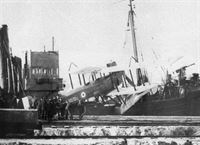Фотографии
-
A Short 310-A4 torpedo-dropping seaplane, which has apparently been recovered at sea by the Donna Nook of Fleetwood, is brought ashore at an unknown dock. Named from the 310 h.p. Sunbeam Cossack engine which powered it (later 320 h.p.), the 310-A4 first flew in July 1916, and most of the 127 built were used for long-range patrol. With a crew of two and a pair of 230lb bombs the aircraft had an endurance of six hours. A further variant, the 310-B, designed from the outset as a patrol seaplane, did not go into production.
Самолёты на фотографии: Short Type 184/225/827/830/310/320 - Великобритания - 1914
-
An unusual air-to-air study of a Sopwith Baby over the North Seo, off Great Yarmouth. The majority of Babies were powered by the 110 or 130 h.p. Clerget rotary engine, and the type made its debut in September 1915. Armament consisted of a single Lewis gun on top of the fuselage decking, synchronised to fire through the propeller arc. A total of 286 Baby seaplanes were built, and 58 were still on charge at the end of October 1918.
Самолёты на фотографии: Sopwith Schneider/Baby - Великобритания - 1914
-
Регистрационный номер: N2071 A fine study of one of the 186 Sopwith Baby seaplanes built in the Olympia Works of the Blackburn Aeroplane and Motor Co Ltd, at Leeds, as "Blackburn Baby seaplanes". Note the manufacturer's distinctive trademark on the fin. This example. N2071, seen at Great Yarmouth, had a 130 h.p. Clerget rotary up front. Of particular interest are the chequered cowling and “lucky black cat” emblem just visible forward of the serial number. A 65lb bomb is slung beneath the fuselage, and the aircraft is provided with both a synchronised Lewis gun on the fuselage and a second, angled Lewis fitted in the centre section.
Самолёты на фотографии: Sopwith Schneider/Baby - Великобритания - 1914
-
Регистрационный номер: N4305, N4308 A sequence of shots depicting a Felixstowe F.2A flying boat, either N4305 or N4308, in the process of being winched ashore at Great Yarmouth. Powered by a pair of 360 h.p. Rolls-Royce Eagle VIII engines, the F.2A entered service from late 1917, serving at virtually every RNAS flying boat station until the Armistice. The beaching procedure was carried out with the engines stopped, and has been described as “no enviable task if there was even a light swell”. The problem was compounded at Yarmouth, where there was often a 6kt cross tide over the slipway.
Самолёты на фотографии: Felixstowe F.2 - F.5 - Великобритания - 1917
-
A Felixstowe F.2A on its beaching trolley at Great Yarmouth or Felixstowe, with one of its two 230lb anti-submarine bombs visible beneath the port wing. These bombs were basically of the depth-charge type, comprising a light case containing a heavy explosive charge detonated under water.
Самолёты на фотографии: Felixstowe F.2 - F.5 - Великобритания - 1917
Статьи
- -
- Industria Valtion Lentokonetehdas A-22 /Preservation Profile/ (59)
- News Spotlight
- Personal album
- A.Jackson - Avro Baby /British pre-war ultralights/ (1)
- B.Gunston - Short's unwanted Shetland
- D.Middleton - Courier Airspeed's innovator (1)
- E.Favelle - Hudson revival
- H.Andrews - McDonnel F3H Demon /Fighters of the fifties/ (18)
- R.Williams - The Siskin saga (2)
- W.Thompson - North American's Twin Mustang (2)




